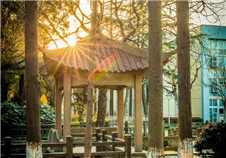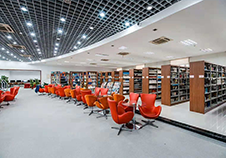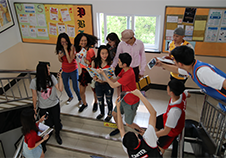
News
SHSID Primary Section: Math Carnival Week
Math in real life is endless. The primary section of SHSID has been dedicated to incorporating real world math into teaching and guiding students to explore and experience the vividness of mathematical concepts from a practical perspective. Since December 7th, each grade of the primary section at Puxi campus has launched several fantastic activities individually based on the different characteristics of their age group.
Dive into Math: Develop the Multiple Intelligences
1st grade was centered around the theme of Curiosity and Imagination to lead students to observe, think, and foster an interest in learning math. During this week, they dressed up with math elements on their clothes and made the winter handwork series by using 2D and 3D models. They also used tangrams to make various shapes they see in daily life. Finally, they created their symmetrical monsters.
2nd grade started with some trending topics in society and solved real-life problems in class. Within only one week, students took on multiple roles. They were experts that decoded number riddles to open treasure chests, workers on an assembly line who distributed food proportionally, providing donations to kids in poverty-stricken areas by using the coins they earned.
3rd grade designed a new commmunity. All the concepts came from math textbooks, like a coordinate grid, geometry, fractions, and patterns. All of them came alive and were displayed as real schools, supermarkets, fields, and hospitals through creative thinking and crafting from 3rd-grade architects.
(Written by: Jenny Zhang, Dolphy Wang, Yonghui Chen, Jingfeng Shen, Yin Wu Pictures by: teachers)






Explore Math Mystery:Stimulate Great Thinking
The theme for 4th grade was Logical Thinking. The activities moved from easier ones to the more challenging ones along the week, pushing their limits. On Monday, students had a warm-up activities—the mixed math crossword, which reviewed four-digit operations. Make 24 is a classic math activity that tested students’ comprehensive math ability. The Sudoku activity on Wednesday was not an easy one. Students needed to first find the clues hidden in the classroom, solved the equations, then enter the solutions into the sudoku, and finally figured it out.
If these activities were too simple for the kids, then the activities on the last two days really challenged the students’ability to apply math skills and knowledge to daily life situations. Our students acted as detectives in solving problems. For example, they used their mastery in time calculation to figure out the culprit’s departure time to help the police to locate hime. By managing the complicated timeline in the clues, they eventually cracked the case. Through this process, students learned five different logical thinking skills and the ability to solve practical problems efficiently and logically.
Every student in fifth grade had a journal as his or her passport for math week. Every time they complete an activity, they received a stamp from their math teacher. Extra stamps would be offered for excellent performances. The number of stamps would be an important reference for final awards and prizes.
The Tower of Hanoi was one of the most popular activities. Using three rods and a number of disks of different sizes, which they can slide onto any rod, the game starts with the disks in a neat stack in ascending order of size on one rod, largest on the bottom and smallest on the top. The objective of the game is to move the entire stack to another rod. House of cards is a game where students construct the tallest possible structure out of a deck of cards and tape. The students experienced the fun of being little builders.
Exploring the secrets of paper airplanes was the most anticipated activity for the students. The mathematics teacher explained the principle of flight of a paper airplane and the physical force it receives. Then the students designed their paper airplanes. After that, they flew outdoors and measured the distance each time. The flight distances were made into a certain graph, combined with the mathmatical knowledge of graphs. Magic Cubes Battle was also a fierce competition game. Both sides put 24 pieces of cubes into the plate and shook the color dice to get the pattern. According to the new pattern, they moved the pieces to organize the correct ones.
In addition, there were Sudoku, Make 24, Origami, and Puzzle games. Each game inspired students’ enthusiasm for mathematics while promoting the development of their abilities and personalities. The students realized the importance of teamwork in solving practical problems and cultivated the awareness for autonomous learning.




Math Carnival Week concluded successfully. Let us start from here and maintain a passion for math learning in everyday life!
(Written by Jenny Zhang, Dolphy Wang, Yonghui Chen, Jingfeng Shen, Yin Wu Pictures by Teachers)











